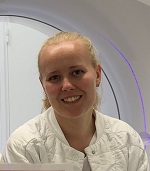Course Report
Positioning and Immobilisation for Radiotherapy - PDF Version
28 May - 29 May, Budapest, Hungary
Course director
- Laura Mullaney, radiation therapist, Trinity College, Dublin, Ireland
Could you please briefly introduce yourself?
I am Anna Green, a radiation therapist (RTT). I live and work in Copenhagen, the capital of Denmark. I started working as an RTT in March 2019, so I've been in the field for a little over three years. My daily work consists of the different aspects of patient treatment as part of the team that works with online cone beam computed tomography-guided adaptive radiotherapy.
Why did you choose to attend this course?
The constant technical development and innovation in the field of cancer treatment, and especially in radiation therapy, is the foundation and source of my interest and the reason why I continue to love what I do. So, when I was offered the opportunity to expand my knowledge and learn from others, then, of course, I accepted.
What aspects of the course were the most interesting and why?
I found the course well balanced between lectures on different subjects and hands-on assignments. I learned a lot from the hands-on assignment, and I was especially fond of the lecture entitled Immobilisation considerations for stereotactic radiotherapy. In my department, stereotactic treatments have been a consistent part of therapy for the last 20 years. The ongoing development and innovation in the field of radiotherapy have affected the selection and in some cases the randomisation of different diagnoses that are treated with stereotactic body radiation therapy (SBRT) in my department. Therefore, it is exciting to hear about different departments’ approaches.
Did the course activities improve your knowledge and skills in the relevant subject?
The reproduction of the immobilisation and positioning of each individual patient is a big part of the work in the radiotherapy department. It is a great way to learn about the different ways and possibilities to get from A to B. As they say: “There is more than one way to Rome.” But it is still important to have collective knowledge and guidelines and to learn from the continued research, innovation and development in the field of radiotherapy from around the world.
Did the course meet your expectations? If so, how?
To be honest, I did not completely know what to expect. I read a lot of articles and guidelines and followed the online lectures in advance. But the course weekend in Budapest was better than I ever expected – very educational.
List three important ‘takeaways’ following the course
- Immobilisation considerations for stereotactic radiotherapy form a large field to explore and there is a lot of material and guidelines from around the world and from the European SocieTy for Radiotherapy and Oncology (ESTRO).
- Preparation of a patient for positioning and immobilisation while applying patient coping strategies and considering the different ways to improve comfort and experience can be a challenge. Therefore, it is good that we have other departments that we can get do's and don'ts from.
- I found especially interesting the lecture called Assessing the effectiveness of an immobilisation device and the short guide called Steps to a research project.
How will what you have learnt be implemented in your daily job/ clinical practice?
I am still quite new in my field. The lecture about how to assess an immobilisation device and the guide about research projects could be starting points for research, innovation and development. In my department and generally in the departments in Denmark, we work with adaptive radiotherapy, and as an RTT who is still at an early stage of my career, I find it exciting to be a part of this process. I could take all the new things I learned from the course into my future clinical practice.
How would you encourage someone who has never been to an ESTRO course to join this course next year/ in two years?
It is a great opportunity to learn something new and to share your clinical knowledge on different aspects of radiation therapy. Attendance at this course offers a good way to get an insight into the equipment used by others around the world and to learn about their daily work. The world is big, and the same treatment may be done all around the world with small or big alterations – which I learned in the case of SBRT.

Anna Green
Radiation Therapist (RTT)
Center for Cancer and Health Copenhagen
Oncology Department - Radiation Therapy
Copenhagen, Denmark
anna.green@regionh.dk